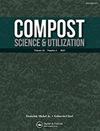马来西亚木质纤维素食品工业废弃物堆肥60天内有机物的演变
IF 0.9
4区 农林科学
Q3 ECOLOGY
引用次数: 3
摘要
摘要为了研究木质纤维素食品工业废弃物的堆肥过程,将空果串(EFB)、咖啡渣(CG)和棕榈油厂污泥(POMS)在实验室中堆肥60天。在实验的第一部分中,EFB、CG和POMS单独堆肥(单一木质纤维素材料的堆肥),在第二部分中,将EFB与CG(1EFB:1CG比例)和POMS(1EFB:1 POMS比例)堆肥。观察了不同翻转频率对堆肥理化性质的影响,并强调了其与降解过程的关系。结果表明,油脂首先被降解,其次是难降解的化合物,如α纤维素、半纤维素和木质素。纤维素和半纤维素主要在堆肥的60天内降解,纤维素/木质素比例的逐渐降低证明了这些废物的主要进化过程。观察到3、6和9天的翻耕频率不影响堆肥的物理化学性质。单独堆肥EFB未能在60天内达到所需的成熟堆肥质量,而CG和POMS的生物活性较低。EFB与咖啡渣和POMS混合堆肥效果较好,到堆肥期第8周,C/N比降至20以下。与单一木质纤维素材料堆肥相比,混合木质纤维素材料的堆肥显示出更大的变化,在8周内达到低于20的C/N比。本文章由计算机程序翻译,如有差异,请以英文原文为准。
Evolution of Organic Matter Within Sixty Days of Composting of Lignocellulosic Food Industry Waste in Malaysia
ABSTRACT Empty fruit bunches (EFB), coffee grounds (CG), and palm oil mill sludge (POMS) were composted in the laboratory for 60 days in order to study the composting process of lignocellulosic food industry wastes. In the first part of the experiment, EFB, CG, and POMS were composted alone (composting of single lignocellulosic material), and in the second part, EFB was composted with CG (1EFB:1CG ratio) and POMS (1EFB:1POMS ratio). The effects of different turning frequencies on the physical and chemical properties of composting were observed and its relation with the degradation process was highlighted. Results showed that oil and grease were first degraded, followed by recalcitrant compounds like alpha-cellulose, hemicellulose, and lignin. Cellulose and hemicellulose were degraded mainly during the 60 days of composting, and the progressive reduction of the cellulose/lignin ratio proved that the main evolution of these wastes took place. It was observed that 3, 6, and 9 days of turning frequency did not affect the physicochemical properties of the compost. Composting EFB alone failed to achieve the required quality of maturity compost within 60 days, while CG and POMS recorded low in biological activity. Better results were shown in composting of EFB mixed with coffee grounds and POMS, the C/N ratio dropped to less than 20 by the 8th week of the composting period. Composting of mixed lignocellulosic materials showed larger changes compared to composting of single lignocellulosic material, reaching a C/N ratio below 20 within 8 weeks.
求助全文
通过发布文献求助,成功后即可免费获取论文全文。
去求助
来源期刊

Compost Science & Utilization
农林科学-生态学
CiteScore
4.10
自引率
0.00%
发文量
0
审稿时长
>36 weeks
期刊介绍:
4 issues per year
Compost Science & Utilization is currently abstracted/indexed in: CABI Agriculture & Environment Abstracts, CSA Biotechnology and Environmental Engineering Abstracts, EBSCOhost Abstracts, Elsevier Compendex and GEOBASE Abstracts, PubMed, ProQuest Science Abstracts, and Thomson Reuters Biological Abstracts and Science Citation Index
 求助内容:
求助内容: 应助结果提醒方式:
应助结果提醒方式:


